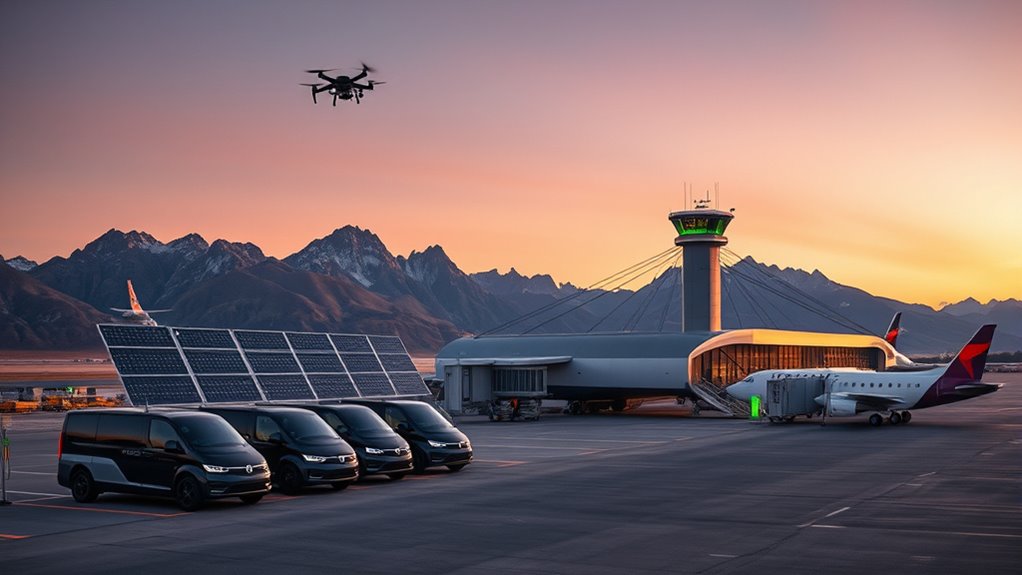Electrifying remote airports faces challenges like limited infrastructure, rugged terrain, and unreliable grid access. You can overcome these hurdles by integrating renewable energy sources such as solar and wind, combined with advanced storage solutions like batteries. Innovative technologies like fast chargers and smart systems help improve efficiency and resilience. If you explore further, you’ll discover how new policies, case studies, and emerging innovations are paving the way for cleaner, more reliable airport operations in remote areas.
Key Takeaways
- Remote airports face power supply challenges due to limited grid access, requiring renewable energy solutions like solar and wind.
- Integrating energy storage systems ensures reliable power during weather fluctuations and night-time periods.
- Infrastructure limitations and logistical hurdles complicate deploying renewable systems and maintaining operations in isolated locations.
- Technological innovations, such as advanced charging and AI energy management, improve efficiency and sustainability.
- Supportive policies, incentives, and emerging smart grid technologies accelerate electrification and reduce reliance on fossil fuels.
Unique Power Supply Challenges in Remote Locations

Remote airports often face significant power supply challenges because they lack reliable connections to centralized grids. Without steady electricity, operational disruptions can occur, affecting safety and efficiency. To address this, many rely on solar panels to generate clean, renewable energy during daylight hours, reducing dependency on fossil fuels. However, solar power alone isn’t enough, especially at night or during cloudy days. That’s where backup generators come in—they provide essential power during outages or low sunlight periods. By combining solar panels with backup generators, you ensure a more resilient power system that keeps operations running smoothly, even in the most isolated locations. This hybrid approach helps mitigate power disruptions and promotes sustainable, reliable energy solutions for remote airports. Additionally, integrating energy storage systems can store excess solar energy for use during non-sunny periods, further enhancing energy reliability.
Infrastructure Limitations and Logistical Hurdles

You’ll find that limited infrastructure makes providing reliable power and transportation tough in remote airports. Access often depends on rugged routes and infrequent connections, complicating logistics. Overcoming these hurdles requires innovative solutions and strategic planning. Implementing advanced technology such as portable power sources and adaptable transportation options can significantly improve operational efficiency in these challenging environments.
Power Supply Challenges
Power supply remains one of the most significant hurdles for airports in remote areas, as their infrastructure often cannot support reliable electricity delivery. Solar challenges pose a major obstacle; limited sunlight during cloudy seasons or at high latitudes reduces solar panel efficiency, making consistent power harder to achieve. Grid limitations further complicate the situation, as existing power networks are often outdated or nonexistent, preventing connection to main electricity sources. You may need to rely on costly diesel generators or battery storage, which are not only expensive but also environmentally unfriendly. Overcoming these issues requires innovative solutions like hybrid systems that combine solar with other renewable sources or energy storage. Additionally, leveraging Honda Tuning technologies such as advanced ECU tuning and hybrid systems can optimize energy use and improve system reliability. Addressing power supply challenges is crucial to ensure reliable, sustainable electricity for remote airports.
Transportation and Access
Limited transportation and access pose significant challenges for remote airports, often stemming from underdeveloped infrastructure and logistical hurdles. Without proper roads, rail links, or reliable ground transportation options, passengers face delays and inconvenience, hampering their overall experience. Urban development around these airports is limited, making it harder to improve access points or integrate modern transit solutions. This isolation discourages travelers and complicates cargo logistics, increasing costs and reducing efficiency. Overcoming these barriers requires strategic planning to enhance connectivity, streamline transportation networks, and adapt infrastructure to meet passenger needs. Improving access not only boosts passenger experience but also supports local economic growth. Additionally, Mazda Tuning techniques can inspire innovative solutions for infrastructure improvements, making them more efficient and tailored to remote environments. Addressing these logistics challenges is essential for transforming remote airports into more accessible, efficient gateways.
Integrating Renewable Energy Sources

Integrating renewable energy sources at remote airports presents both significant opportunities and complex challenges. Solar integration allows you to harness abundant sunlight, reducing reliance on fossil fuels and lowering operational costs. Installing solar panels on rooftops or open land can provide a steady power supply, especially during daylight hours. Wind harnessing offers another reliable option; if your location features consistent wind patterns, turbines can generate substantial electricity. Combining solar and wind systems maximizes energy production and ensures greater resilience against weather variability. Additionally, understanding personality traits can be beneficial in managing diverse teams involved in renewable energy projects, fostering better collaboration and problem-solving. However, integrating these renewable sources requires careful planning to address site-specific factors, such as terrain and climate. Effective assessment and strategic placement enable you to optimize renewable energy potential, ultimately making remote airports more sustainable and less dependent on external power grids.
Storage Solutions for Off-Grid Operations

Effective storage solutions are essential for maintaining reliable off-grid operations at remote airports. Battery storage systems enable you to store excess energy generated from renewable sources or backup power during low demand periods. This guarantees a steady power supply, even when sunlight or wind is unavailable. Good energy management is key—by optimizing when and how you use stored energy, you can reduce waste and extend battery life. Advanced battery technologies, like lithium-ion or flow batteries, offer high capacity and durability, making them suitable for remote settings. Properly integrated storage solutions help balance supply and demand, improve system reliability, and lower operational costs. Additionally, selecting appropriate cultivation methods ensures the longevity and efficiency of the storage infrastructure. In off-grid environments, effective energy storage becomes the backbone of a resilient, sustainable power infrastructure.
Technological Innovations Driving Electrification

Technological innovations are transforming how remote airports achieve electrification, making operations more efficient and sustainable. Advanced charging technologies enable faster, more reliable power delivery in isolated locations, while sustainable power sources reduce dependence on fossil fuels. Together, these advancements are paving the way for cleaner, more resilient airport infrastructure. Incorporating high-efficiency energy systems can further optimize energy use and support long-term sustainability goals.
Advanced Charging Technologies
Advancements in charging technologies are rapidly transforming how remote airports support electric aircraft operations. You can now leverage wireless charging to simplify the process, reducing ground handling time and increasing efficiency. Fast chargers enable quick turnaround times, ensuring aircraft spend less time on the ground and more in the sky. These innovations bring several emotional benefits:
- *Reduced emissions, protecting your community’s health*
- *Faster charging, boosting operational confidence*
- *Streamlined procedures, easing airport workflows*
- *Cutting-edge tech, inspiring confidence in the future* Additionally, integrating training and socialization programs for ground staff can improve safety and efficiency during charging procedures.
With these advanced charging options, you’re empowering remote airports to lead the transition to sustainable aviation. The integration of wireless charging and fast chargers marks a pivotal step forward, making electric flight more practical and accessible for all.
Sustainable Power Sources
As remote airports shift toward electrification, harnessing sustainable power sources becomes essential for reducing carbon footprints and ensuring long-term viability. Solar integration offers a reliable way to generate clean energy, especially in sunny regions, by installing photovoltaic panels that supply power directly to airport operations. Wind energy is another promising option; wind turbines can harness local wind patterns to produce consistent electricity. Combining solar and wind technologies creates a diversified energy portfolio, increasing resilience and minimizing reliance on external grids. These innovations not only cut emissions but also lower operational costs over time. By investing in sustainable power sources, remote airports can achieve energy independence, improve environmental sustainability, and support future growth without compromising ecological integrity.
Case Studies of Successful Remote Airport Electrification

Remote airports face unique challenges in implementing sustainable power solutions, but several have successfully shifted to electrification through innovative approaches. One notable example is the use of solar integration, which provides reliable energy while reducing costs. Community engagement played a crucial role, fostering local support and shared ownership of projects. These airports have:
- Transformed isolated locations into models of sustainability
- Improved operational reliability with renewable energy sources
- Built strong local partnerships that ensure project longevity
- Inspired nearby communities to pursue similar initiatives
Furthermore, embracing renewable energy sources has been pivotal in overcoming logistical hurdles and ensuring long-term success.
Policy and Regulatory Support for Sustainable Airports

Effective policy and regulatory frameworks are essential to accelerating the adoption of sustainable practices at remote airports. You need clear rules that encourage investment in electrification and renewable energy projects. Well-designed regulatory frameworks provide certainty, making it easier for stakeholders to commit resources. Policy incentives, such as grants, tax breaks, or reduced tariffs, motivate airport operators and airlines to prioritize sustainability. Governments can also set standards for emissions and renewable energy use, ensuring consistent progress. By streamlining permitting processes and offering dedicated support, you create an environment where sustainable innovations thrive. Strong policies not only promote environmental benefits but also enhance operational resilience and cost savings, making electrification a practical and attractive option for remote airports. Additionally, understanding the importance of Relationships – Personality Test can help stakeholders foster collaboration and trust, which are crucial for implementing complex sustainability initiatives.
Future Trends and Emerging Technologies

Advancements in technology are shaping the future of remote airports, making sustainable operations more feasible and efficient. Smart grid integration will enable airports to manage energy consumption dynamically, reducing waste and ensuring reliable power. You’ll see increased electric vehicle adoption, not only for ground transportation but also in airport infrastructure, cutting emissions considerably. Emerging technologies like autonomous drones for maintenance and AI-driven energy management systems will streamline operations and enhance sustainability.
- Imagine a fully electrified airport with zero emissions, powered by intelligent energy systems
- Picture electric vehicles seamlessly integrated into airport logistics and passenger transport
- Feel the excitement of innovative solutions that reduce operational costs and environmental impact
- Envision smarter, safer, and more resilient remote airports prepared for the future
Building Resilience and Ensuring Reliability

Building resilience and guaranteeing reliability are vital for remote airports to operate smoothly amid unpredictable conditions. You should invest in backup generators to maintain power during outages, preventing disruptions to flights and safety systems. Achieving grid independence is essential, so rely on renewable energy sources like solar or wind alongside energy storage solutions. This reduces dependence on external power grids that may be unreliable or inaccessible. Regular maintenance of backup generators ensures they function effectively when needed. Installing robust monitoring systems allows you to detect issues early and respond swiftly. By combining backup generators, renewable energy, and strategic planning, you create a resilient infrastructure that withstands extreme weather, technical failures, and logistical challenges. This approach guarantees consistent operations, safety, and passenger confidence at your remote airport.
Frequently Asked Questions
What Are the Cost Implications of Electrifying Remote Airports?
When considering the cost implications of electrifying remote airports, you need to conduct a thorough cost analysis. This process helps you understand the infrastructure investment required for renewable energy sources, charging stations, and upgrades. While initial expenses are high, you’ll likely see long-term savings through reduced fuel costs and emissions. Balancing upfront costs with future benefits is vital for making the project sustainable and financially viable for your operations.
How Do Remote Airports Manage Maintenance With Limited Access?
Did you know that remote airports often rely on specialized teams for solar maintenance? You manage maintenance by planning access logistics carefully, often using helicopters or off-road vehicles to reach difficult locations. Limited access means you prioritize preventive measures and remote diagnostics to reduce downtime. This way, you guarantee safety and efficiency, even in the most isolated areas, maintaining reliable operation despite logistical challenges.
What Training Is Needed for Local Staff to Operate New Systems?
You need to develop extensive training programs focused on improving staff competency to operate new systems effectively. These programs should include hands-on instruction, safety protocols, and troubleshooting techniques. By ensuring your local staff receives ongoing training, you help them stay updated on system upgrades and maintain operational efficiency. This approach minimizes errors, enhances safety, and boosts confidence, making sure your remote airport functions smoothly despite limited access.
How Do Weather Conditions Affect Renewable Energy Performance?
Ever wondered how weather impacts renewable energy? You should know that solar variability causes output fluctuations on cloudy days, while wind unpredictability leads to inconsistent generation. These factors challenge energy reliability, especially in remote airports relying on renewables. Understanding these weather effects helps you plan better, ensuring a steady power supply. By adapting to these conditions, you can maximize renewable efficiency and reduce dependence on traditional energy sources.
Are There Global Standards for Remote Airport Electrification?
You might wonder if there are international standards for remote airport electrification. While specific standards vary, global organizations like ICAO emphasize safety protocols and interoperability. These standards help guarantee reliable, safe, and efficient electrification systems across different regions. Adhering to international guidelines, airports can standardize procedures, improve safety, and facilitate the adoption of renewable energy solutions, ultimately supporting the shift toward greener aviation infrastructure worldwide.
Conclusion
You see, electrifying remote airports isn’t just about installing solar panels or batteries. It’s about overcoming challenges, embracing innovations, and building resilience. It’s about managing logistics, integrating renewables, and ensuring reliability. It’s about pushing limits, pioneering solutions, and shaping a sustainable future. By tackling these hurdles head-on and staying committed, you help create airports that are not only powered but also prepared—ready to connect communities, support growth, and inspire progress.










